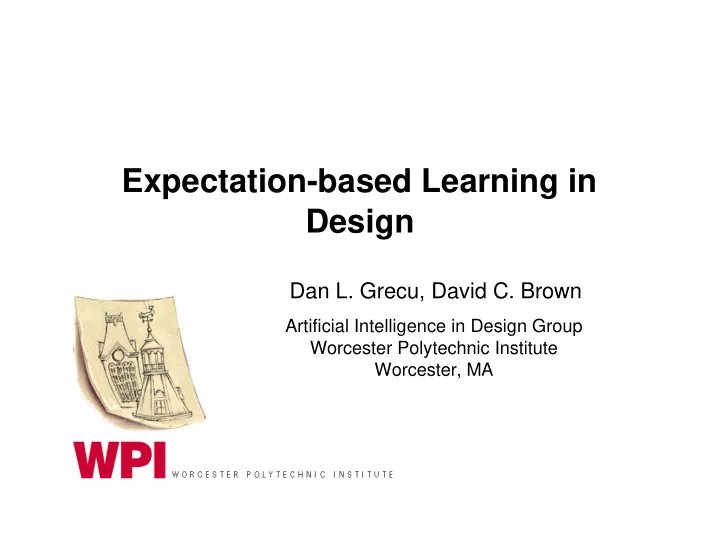

Expectation-based Learning in Design Dan L. Grecu, David C. Brown Artificial Intelligence in Design Group Worcester Polytechnic Institute Worcester, MA
C HARACTERISTICS OF D ESIGN P ROBLEMS 1) Problem spaces are typically very large. 2) Design solutions integrate decisions generated through a variety of problem-solving strategies , based in different domains . 3) Ordering of decisions is not pre-defined . 4) Problem-solvers (agents) act in various roles : decision-makers, critics, evaluators etc. A global approach to solution improvement through learning is difficult to design and implement.
M ULTI -A GENT L EARNING IN D ESIGN Other Other Design Design agents agents Information Partial information receives receives Knows consequence Has limited knowledge DESIGN of every design decision DESIGN to support its decisions AGENT in any design state and and limited knowledge AGENT for any set of agents about their consequences computes computes Design Selected based Selected based on Design on utility criteria heuristic criteria decision decision Ideal Evaluate Real consequences update world world
L EARNING IN D ESIGN N EEDS T O B E F LEXIBLE Flexible learning requires design agents to know ➠ when there is a need for learning, ➠ how to respond to a need for learning in terms of: – supporting information sources , e.g., design parameters, dependencies, etc. – defining the learning target , e.g., the material strength in a manufacturing process – selecting the learning strategy/algorithm , e.g., induction, EBL ➠ when a learning process should be stopped .
E XPECTATIONS IN D ESIGN Expectation = an agent’s belief that an event will occur in a pre-defined way ➠ captures the conditions that will generate a specific situation Example: design information design agent information IF The material is high carbon steel Manufacturing is at a remote site ( > 100 km) There is no cost agent present THEN The resulting component price will exceed $45.00
C HARACTERIZING E XPECTATIONS Expectations ➠ have an empirical character in that often there is no deductive connection between the observed conditions and the situation that is predicted ➠ are a tentative form of knowledge that has to be: – set up – monitored and up-dated – validated or rejected ➠ are learned as concepts , i.e., conditions that characterize an event, and are used as rules
T HE O BSERVABLE W ORLD OF AN A GENT The collection of features, in the design domain and in the agent environment, that an agent can ‘perceive’, such as – the roles/specializations of other agents – the posted design decisions – the conflicts between agents ➟ Delimits the basis of learning (learning bias) ➟ Is constrained by an agent’s functionality and specialization. ➟ Is restricted by physical information distribution factors.
E XPECTATION - BASED D ESIGN D ECISION - MAKING modify propose design Knowledge decision Design about Observable designing world of a evaluate Expectations consequences design design Knowledge decision agent YES Other about accept agents agents revise decision Design Agent influence Expectations are involved both in proposing a design decision and in evaluating its consequences.
R OLE OF E XPECTATIONS IN D ESIGN Expectations compensate for an agent’s limited power to know or to infer what will happen in the design system. ➟ Expectations extend a design agent’s awareness . ➟ Expectations enhance a design agent’s power of anticipation . ➟ Expectations express an agent’s interests . Determine what may be learned.
L EARNING E XPECTATIONS Observable Meta-reasoning module world of the design agent selects features candidate that may Design features influence expectation determines relevant External features and features Internal features their values Learning Other module Agents generates Expectation conditions Design Agent
I NITIATING E XPECTATION A CQUISITION Part of the process of evaluating the consequences of a proposed design decision: ➟ The design agent tries to determine whether the proposed decision will a) violate a constraint or requirement, and/or b) satisfy/support a design goal � The agent applies backward inference to verify goal/constraint satisfaction based on its current knowledge. � Repeatedly ‘missing’ rule preconditions are posted as candidate targets for expectation.
L EARNING E XPECTATIONS – A N E XAMPLE Spring Design Agent – selects diameter = 15 mm – needs to know cost of component triggers Spring Design Agent Meta-reasoning module selects candidate features for violation: – choice of material (internal feature) use – range of stress (external design feature) – manufacturing site (external design feature) – presence of cost critique agent (external agent feature) collect training data Spring Design Agent IF material = high carbon steel Learning module determines that cost is influenced by manufacturing site > 100 km – choice of material critique agent = not present – manufacturing site THEN – presence of critique agent generate cost > $45.00 Expectation in rule form
S ELECTION OF C ANDIDATE C ONDITIONS � Depends on the type of expectation that is being developed, i.e., design or design-process oriented � Is based on causal attribution knowledge: ➟ Known dependencies between design parameters ➟ Actions of agents that include the object of the expectation in their domain ➟ Occurrence of specific design process events, such as absence/presence of specific agents, conflicts, redesign phases
S ELECTION OF R ELEVANT C ONDITIONS Inductive learning algorithm Meta- Revised reasoning expectation module Relevant Accuracy feature testing selection Wrapper Candidate Features in Learning Module features for the observable learning world of the agent
M ONITORING E XPECTATION V ALIDITY Value resulting from use of expectation yes Add violation Occurrence of Expectation Retrain instances to violations is violation yes training set reduced no Eliminate expectation Value resulting from design process
E VALUATION M ETHODOLOGY Evaluation focuses on the design and design process impact resulting from 1. combining expectations about design and about the design process, 2. the size of the observable agent worlds, 3. the causal attribution knowledge, 4. the interferences between learning processes, and 5. the ‘moving targets’ created by learning.
Recommend
More recommend